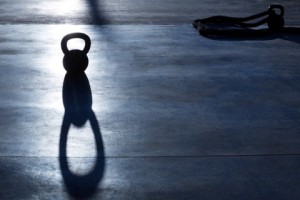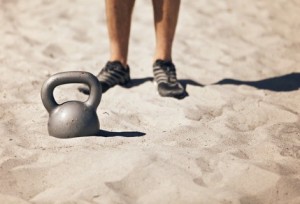 Probably the single biggest reason kettlebell workouts continue to grow in popularity is their combination of strength building and cardiovascular exercise. In the process, it also improves joint mobility. It’s all possible due to the shape of the kettlebell itself.
Probably the single biggest reason kettlebell workouts continue to grow in popularity is their combination of strength building and cardiovascular exercise. In the process, it also improves joint mobility. It’s all possible due to the shape of the kettlebell itself.
Anatomy of a Kettlebell
Consisting of a solid mass, there’s no worry about weight plates or anything else flying or falling off while in use. With the bulk of the kettlebell’s weight located beyond its handle, it practically forces the user to handle it with a swinging motion that’s the key characteristic of kettlebell workouts. While there are a huge number of exercise routines, a few stand out for their ability to engage multiple muscle groups throughout the body.
Kettlebell Swing
The swing is designed to primarily build the lower back and hips and consists of two components. The first part of the routine involves slightly straightening the knees so that the kettlebell just clears the floor while the upper back muscles are used to draw it back between the legs. Once the weight is at this location, the individual straightens their legs and back completely so that the arms momentarily swing forward to a position parallel with the floor before dropping back down.
One-arm Clean
This exercise stresses the bicep muscles, shoulders, quadriceps, and glutes. Using a continuous motion, bend at the knees to grasp a kettlebell on the ground while keeping your palm parallel to your side. Moving to a standing position, pull the weight up to shoulder height while simultaneously rotating your palm inward before returning to the original position.
Kettlebell Row
 Emphasizing the lats of the upper back, the kettlebell row strongly resembles a standard dumbbell row, and the routine begins by keeping the back straight while leaning over with the knees slightly bent and the opposing hand on a bench for support. The kettlebell is gripped by the free hand and is drawn up to the your side. The bicep and shoulder muscles are also involved, and the kettlebell row has the advantage of allowing you to bring the weight past your side on the upstroke due to the shape of the weight.
Emphasizing the lats of the upper back, the kettlebell row strongly resembles a standard dumbbell row, and the routine begins by keeping the back straight while leaning over with the knees slightly bent and the opposing hand on a bench for support. The kettlebell is gripped by the free hand and is drawn up to the your side. The bicep and shoulder muscles are also involved, and the kettlebell row has the advantage of allowing you to bring the weight past your side on the upstroke due to the shape of the weight.
Lunge Press
This routine utilizes a wide range of muscle groups including the shoulders, upper back, triceps, glutes, and thighs while also teaching proper form. The exercise begins with a standing position while the weight is held against the chest with both hands grabbing the outer edges of the handle. While lunging forward on one leg while the other leans just above the floor, the weight is pushed up above your head.
One-handed Floor Press
Starting out by lying on your back on the floor, this movement is focused on working the triceps, shoulders, and pectoral muscles in the chest. Clutching the kettlebell sitting beside you with your palm facing towards you, raise the weight above you while also twisting your arm to position your palm towards your waist. Then lower the kettlebell back to the floor.
